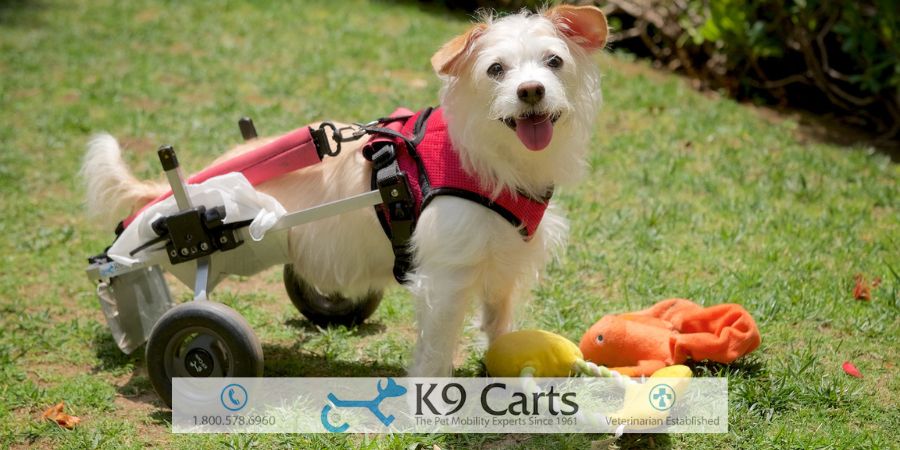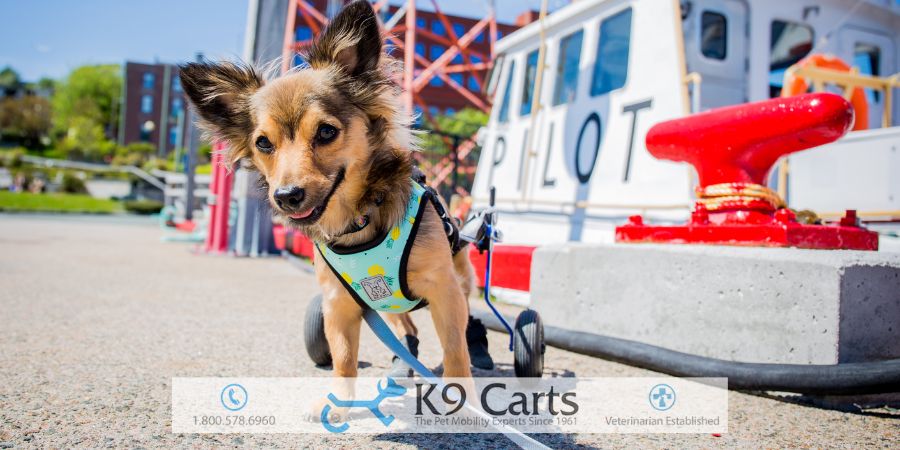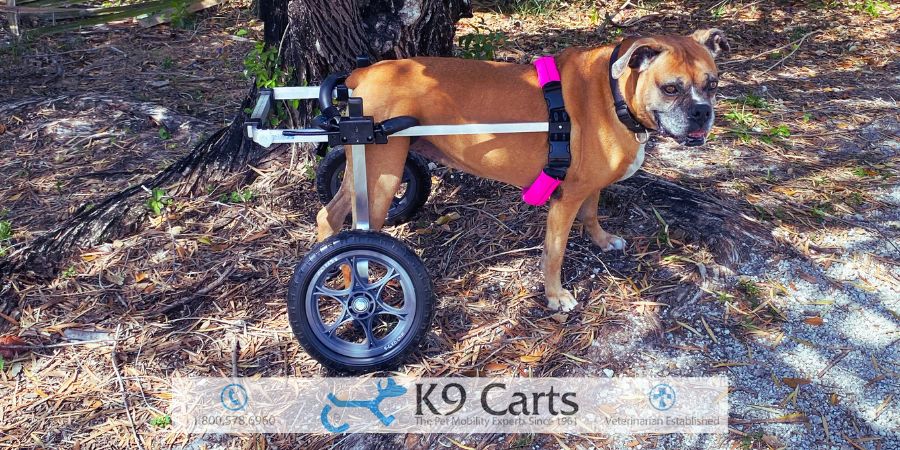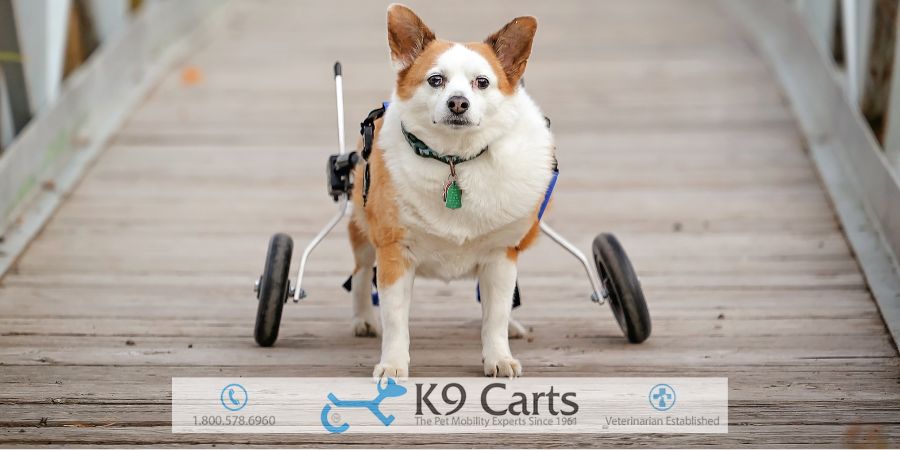Dog Leg Amputation: How Much it Costs, Recovery, and Aftercare

When our four-legged friends face unexpected life challenges, it's our heartfelt desire to give them all the love, care, and support they need. A dog's leg amputation can be a distressing event for both pet and owner, casting a cloud of uncertainty over their future. But here's the silver lining: just as human amputees learn to live fulfilling lives post-amputation, so can our canine pals.
Dogs are resilient, adaptive, and astonishingly full of spirit. With the right guidance and resources, like the custom-built dog wheelchairs from K9 Carts, dogs can lead joyful, active lives even after amputation. Join us on this journey as we explore the ins and outs of dog leg amputation, from understanding its causes to celebrating the vibrant life your pet can have afterward.
Why Might a Dog Need a Leg Amputation?
We often imagine our dogs bounding joyfully in the park, wagging their tails with carefree abandon. However, life can throw a curveball, sometimes leading to situations where a leg amputation becomes a necessity.
It's crucial for us to understand the various reasons that could lead to such a decision. This understanding not only empowers us to take the best possible care of our furry family member but also to provide them with optimal support during their transition.
1. Severe Leg Trauma
Accidents happen. Dogs, being the curious and adventurous creatures they are, can sometimes find themselves in situations where they suffer significant leg injuries. Be it a mishap with a moving vehicle, a bad fall, or an unfortunate tangle with a larger animal; trauma can result in irreparable damage to a leg, making amputation the safest and most humane option.2. Severe Leg Infection
Infections can be sneaky. What starts as a small wound or cut can sometimes escalate to a severe infection if not treated promptly. In extreme cases, when the infection penetrates deep into the tissues and bones, it could threaten the dog's life. In such instances, amputation becomes a lifesaving measure to prevent the spread of the infection.3. Limb Paralysis
Certain medical conditions or injuries can lead to paralysis of a limb. When the leg becomes non-functional over an extended period, it can be prone to sores, infections, or other complications. If these issues become chronic and impact the dog's quality of life, amputation can be considered.4. Severe Limb Deformity or Malformation
Some dogs may be born with, or develop, severe limb deformities or malformations that can hinder their mobility or cause them pain. While many of these dogs adapt and live comfortably, in cases where the deformity causes chronic pain or significant mobility issues, amputation can offer a better quality of life.5. Bone or Soft Tissue Leg Cancer
This is perhaps one of the most common reasons for dog leg amputations. When a dog develops cancer in a leg, and the malignancy is aggressive or located in such a way that it can't be removed with a localized surgery, amputation becomes a method to remove the primary tumor source, potentially saving the dog's life.
While the very thought of our beloved dogs undergoing an amputation can be heart-wrenching, it's essential to remember that these decisions are made with their best interests at heart. Veterinary professionals recommend such procedures only when they believe it will provide the dog with a pain-free and improved quality of life.
And, as we'll explore later, life on three legs – especially with the support of tools like K9 Carts' custom-built wheelchairs – can be filled with joy, play, and tail-wagging happiness.
How Much Does a Dog Leg Amputation Cost?
Depending on where you reside (metropolitan vs. small town), and the specific care involved, you could be looking at anywhere from $700 to $1,500. This sum encompasses everything: anesthesia, pain management, post-op care, and those elegant Elizabethan collars. We'd also suggest keeping an eye out for any follow-up treatments or accessories your furry pal might need.Preparing for a Dog's Leg Amputation
There's no denying that the decision to amputate your dog's leg can be heavy on the heart. But once the decision is made, preparation is key to ensuring your fur baby's health and well-being. We know the anxiety, the myriad questions, and the worry that follows. Fear not, for we're here to arm you with information and support every paw step of the way.1. Consult with Your Vet
This might sound obvious, but it's fundamental. Your veterinarian will provide guidance on pre-surgery preparations. They might require blood tests, x-rays, or other diagnostics to ensure your dog is a good candidate for surgery.2. Home Prep
Think of the post-surgery period. Slippery floors? You might want to consider laying down rugs or mats to give your dog better traction. Their favorite resting spot upstairs? Consider setting up a temporary comfy space on the ground floor, so they don't have to navigate stairs immediately post-surgery.3. Nutrition
Just as with humans, proper nutrition can aid in recovery. Discuss with your vet about any dietary changes or supplements that might benefit your dog during this time.4. Mental Preparation
We often focus on physical aspects, but your dog will pick up on your emotions. It's essential to approach the situation with a positive outlook, showing your dog love and reassurance. This positive energy can make a world of difference in their recovery.5. Post-Surgery Needs
Consider what your dog might need immediately after the surgery. This could include medications, wound care supplies, or even that dreaded cone of shame (though there are more comfortable alternatives nowadays).6. Research Mobility Aids
And while we're on the topic of preparations, it might be worthwhile to start researching mobility aids. We've seen countless dogs get a new lease on life with our custom-built wheelchairs at K9 Carts. These wheelchairs can offer your dog support and freedom, especially during the transitional phase after surgery.7. Questions for the Vet
Create a list of questions or concerns you have and discuss them with your vet before the surgery. Understanding the procedure, risks, and post-operative care can ease a lot of anxiety.How Is Leg Amputation Surgery Performed on a Dog?
Peering behind the curtain of the surgical realm can help demystify the process. We're not taking you into an episode of "Grey's Anatomy," but it's beneficial to understand the basics of the amputation procedures your fur baby might undergo. And trust us, our four-legged friends are astoundingly resilient.1. Proximal Femoral Amputation
In this procedure, the leg is amputated close to the hip joint. This means the entire leg, right from the hip, is removed. The reason this method is employed can often be due to tumors located on the upper thigh or hip. The upside? Dogs adjust relatively well after this procedure due to the even weight distribution on their remaining legs.2. Scapulothoracic Disarticulation
Sounds a bit technical, doesn't it? Simply put, this method involves the removal of the entire front leg along with the shoulder blade. It's often chosen when the conditions affect the shoulder area or upper portion of the front leg. Once again, the absence of a stump means dogs usually adapt smoothly post-surgery.3. Coxofemoral Disarticulation
Here, the amputation is performed at the hip joint level. Unlike the Proximal Femoral Amputation, a portion of the femur (or the thigh bone) is left intact. This might be the chosen method if the affected area is localized more towards the knee or mid-thigh region.4. Hemipelvectomy
Of all the procedures, this one is the most extensive. Hemipelvectomy involves removing not just the leg but also a portion of the pelvis. It's a choice made for conditions that affect the pelvis area or when the disease has spread from the leg to the pelvis.
The choice of amputation method is a calculated decision made by your veterinarian based on the location and extent of the disease or injury. While the thought of surgery can be daunting, understanding the process can help you feel more empowered.
And when it's all said and done, we've witnessed countless tales of triumphant tails wagging their way to a full, joyful life post-surgery. And if your canine companion needs a little boost in mobility during their recovery or transition, remember that we at K9 Carts are here with the perfect ride for them.
Recovery after Dog Leg Amputation
Post-surgery, the journey to recovery and adaptation begins. The road may be sprinkled with challenges, but with love, patience, and a sprinkle of know-how, the journey can become a story of inspiration.The Recovery Period
After surgery, your dog will spend a bit of time at the clinic. Once they're back home, a comfortable, quiet space is paramount. Remember, these champs have been through a lot, and they deserve all the pampering! Ensure the stitches or staples are kept clean and dry. Also, keep an eagle eye out for signs of infection, like redness, swelling, or discharge.Learning to Walk on Three Legs
Nature’s wonderful, isn’t it? Dogs have an uncanny ability to adapt quickly. Your fur baby will soon start figuring out their new way of walking. Initially, there might be a bit of wobbling or even the occasional tumble. But give it some time. Before you know it, they'll be racing to the doorbell or chasing after their favorite ball, just like old times.Caring for Your Dog Post-Amputation
Diet and exercise: Key to recovery. A balanced diet ensures they don't gain unnecessary weight, which could strain their remaining legs. While it's tempting to shower them with treats, maybe opt for a cuddle session instead. As for exercise, short, supervised sessions in the beginning are your best bet. Gradually increase the time as they gain more confidence and strength.Challenges Faced by Dogs with Leg Amputation
Navigating a world designed for four legs with just three can certainly bring about some hurdles. Yet, it's heartwarming to see the resilience and tenacity of our furry pals. Let's explore some of the challenges they might face and, more importantly, how we can lend a paw in helping them overcome these.1. Emotional and Behavioral Changes
Dogs, just like humans, go through a gamut of emotions after a significant life change. Some might become withdrawn, while others might display signs of anxiety. It's essential to remember that they're not just healing physically but emotionally too. Patience, love, and perhaps a few extra belly rubs can go a long way. If your pup seems overly distressed, consulting with a vet or pet therapist might be a good call.2. Mobility and Balance Issues
Missing a leg can affect a dog's balance and coordination. Surfaces that were once easy to tread can now become a challenge. Providing rugs or mats on slippery floors and perhaps a ramp instead of stairs can be a huge help. It's all about making slight adjustments to their environment.3. Maintaining Muscle Strength and Joint Health
With three legs bearing the weight once shared by four, it's crucial to ensure the remaining limbs stay strong and healthy. Gentle exercises and physiotherapy can be beneficial. Plus, consider supplements that support joint health, after consulting with your vet, of course.Life on Three Legs: Helping Your Dog Cope
Losing a limb can indeed bring about a whirlwind of emotions, not just for you but for your pup too. It's a change, and like all changes, it requires adaptation. The first step is to recognize their feelings. Dogs might grieve the loss, feeling disoriented, or perhaps even depressed. Patience, love, and the power of touch are your best allies. Extra cuddles, gentle words of encouragement, and perhaps even some of their favorite treats can provide comfort during this adjustment period.Adapting with a Prosthetic Leg
While not all dogs are candidates for prosthetic legs, it's an avenue worth exploring. These tailor-made devices can restore some degree of mobility and independence. Remember, the goal isn't to replicate the functionality of a natural leg, but to provide support, balance, and a semblance of their former mobility.Adapting with a Dog Wheelchair
Here's where the magic happens. Our fur-babies, when fitted into a perfectly suited wheelchair, find a burst of joy, almost reminiscent of their puppy days.
K9 Carts' custom-built dog wheelchairs are more than just a mobility aid. They're a lease of renewed spirit, zest, and enthusiasm. Designed keeping in mind the unique needs of each dog, they can make a world of difference in the life of a canine amputee. The streets, parks, and even beaches become their playground again, all thanks to the perfect blend of design and love poured into these wheelchairs.
Dog Wheelchairs and Leg Amputation
Ah, the heart of today's discussion! When your furry friend can't gallop with the same gusto as before due to an amputation, it doesn't mean they can't still feel the wind in their fur. A dog wheelchair is a specially designed contraption to give our pals the freedom to roam, frolic, and play.Benefits of a Dog Wheelchair
There's a bucketful of advantages a dog wheelchair offers, but we'll highlight the major ones:- Mobility Restored: Running, playing, even simply walking to their water bowl becomes achievable.
- Physical Health: Regular exercise means muscles stay toned and cardiovascular health remains optimal.
- Mental Health Boost: There’s something deeply rewarding about seeing their tails wagging again, free from the constraints of immobility.
- Independence: Just like us, dogs cherish independence. A wheelchair grants them the liberty to explore on their own terms.






